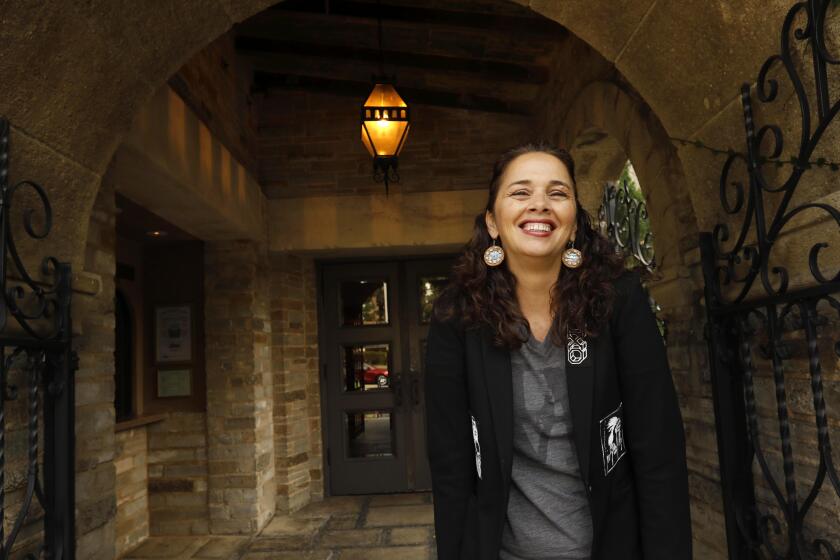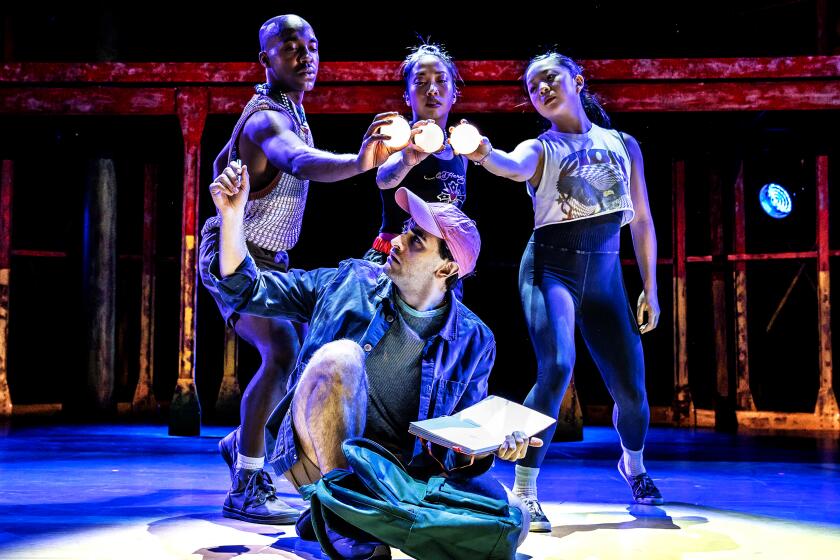New Exhibits Get S.D.’s Art Season Off to Impressive Start
Two of San Diego’s less-prominent venues for exhibiting art are ushering in the new season with shows that, like their sites, may be quiet but are utterly absorbing.
Grossmont College’s Hyde Gallery is presenting an array of mixed media works by Richard C. Herman, an artist whose technical range spans as wide as his thematic well runs deep. At Sushi, the downtown performance art and gallery space, a collaborative installation by Melanie Walker, Susan Stone and John Tangenberg turns viewers into captivated voyeurs, while drawings by local artist Cheryl O’Neill stoke the mind’s philosophical fires.
Herman’s Hyde Gallery show penetrates slowly, but when its haunting images and poignant tone do sink in, they lodge themselves deep in the psyche. Herman is both an analyst and a victim of violence--not necessarily the physical variety, but especially violence inflicted on the spirit. A native of Panama’s Canal Zone, he spent 10 of his formative years in Venezuelan oil camps and another two seminal ones fighting with the 1st Infantry Division in Vietnam. He now serves as teacher and administrator of the art program in the California Correctional Institution in Tehachapi.
While the enduring pain of his experiences filters through all of his work, two of the most gripping works in the show confront the violence of war head-on. “Blue Hyenas” is a wall-mounted book with pelt-like pages of thick, handmade paper. Only six pages long, it conjures up deep, disturbing evocations of war. Each page bears only a few words and often a small object glued to the surface.
“Captain America screams” echoes across one page; “Camouflage didn’t always work” lands with a hollow thud on another. And finally, on the last page, a small plastic box serves as a coffin for the words, “Everyone got a medal.” Among his hallucinatory images of a shattering, rough-edged drama, Herman’s memory of this puny reward gives “Blue Hyenas” the impact of an epic tragedy.
In “Trip Wire,” a wall-mounted relief of painted wood and other objects, Herman reconstructs a typical scene from the war zone, but he charges it with the same current of disarming fantasy that gave the film “Apocalypse Now” its unique place in the annals of war movies.
In Herman’s work, a camouflaged soldier is seen walking through foliage toward a thicket, where a trip wire awaits his step. Beneath the ground we see the holder of the wire, a man with a head of thorns and a belt strung with fetishes, including a dart and a miniature toy gun. Equally spry and malicious is a collared beast that lurks in the thicket, a hot pink ball clenched between its jaws.
Men often appear as pawns in Herman’s work, as obedient performers in a game plan that calls for order and control. Human acrobats perform their tricks in his poignant wooden sculptures and dogs jump through hoops as well, in sculptures and drawings. Analogies are not hard to draw between these sorrowful servants of a meaningless order and the military men obeying orders from above.
A strong sense of compassion also floats through this show--Herman’s own compassion for the human condition and the desperate compassion of individuals for each other. In his drawn and sculpted images of dancers, the figures cling to one another so hungrily that their two bodies ultimately merge. Male sexuality plays a substantial role in this work, too, and feels appropriately linked at times to the military instinct for violence.
Herman’s work touches many a raw nerve in the American psyche, but it does so with a sensitive hand, one that never yields to the temptation of sensationalism. It embodies that duality of crudeness and refinement that is so basic to humans and that causes one to review the history of human endeavor with some melancholy.
At Sushi, artists Walker, Stone and Tangenberg focus on the city and the home as hubs of human enterprise and emotion. Across one long, curving wall, they have hung a large aerial photograph of an unnamed city. Facing the photograph are nine miniature, nearly identical white stucco houses mounted to the wall at eye level. Each contains lighting and audio components, triggered by a sensor in the gallery, so that the interiors come alive as viewers approach them.
The aerial photograph of the city, with its distanced view of anonymous structures, acts as a brilliant counterpoint to the sometimes painfully intimate glimpses we are afforded into the houses. One house feels much like an Edward Hopper painting brought to life. Through a small window, we see a single room with a bed in the far corner. Light, rising and falling, passes through a lace curtain on the room’s other window and casts shifting, web-like patterns on the walls, papered poetically enough with dried leaves. This mesmerizing view is accompanied by a taped narrative describing, however vaguely, a woman in captivity.
Another house could spring straight from the rich prose of William Faulkner. Moss climbs the interior walls, suffocating the old family photographs hanging on them, while the loud, persistent ticking of a clock can be heard, along with a woman’s voice describing the oppressive heat. Other houses offer nostalgia, and yet others afford a horrific glimpse at the mechanistic sterility of modern life. Shelves of jarred fetuses fill one house. Another contains only a telephone, on which we hear a disorienting and indiscernible electronic voice.
Walker, Stone and Tangenberg have titled their work “Omphalos,” the Greek word for navel or center, also the name of the sacred stone in the temple of Apollo at Delphi that was fabled to mark the center of the earth. In this installation, made last year when all three artists lived in San Francisco (they now live in three different cities), both the city and the individual home serve as centers of life. One is the macrocosm, the other the microcosm, but both house an abundant and sometimes overwhelming array of emotions, memories, expectations and dreams.
In their gallery statement, the artists invite the visitor to be “guest, tourist, detective, observer, intruder, pedestrian, voyeur, passenger, inhabitant,” all the roles, in fact, that the city dweller plays daily in the normal course of events. Few, however, stop to examine these roles. This installation provides a perfect, provocative opportunity to do so, and to consider all of the sacred, scientific, social and sensual implications of the “hub” itself.
Three works by O’Neill are somewhat overshadowed by the “Omphalos” installation, but they, too possess depths worth exploring. Dense montages of words, illustrations and other images, these drawings on paper, felt and chalkboard deal alternately with the loss of life, innocence and dignity, contemporary culture’s snubbing of spiritual values and the need to remain conscious of the systems that bind us.
Hyde Gallery, Grossmont College, 8800 Grossmont College Drive, El Cajon, through Oct. 4. Open Monday through Friday 10-4.
Sushi Performance and Visual Art, 852 8th Ave., through Oct. 5. Open Friday and Saturday 12-4 and by appointment (235-8466).
CRITIC’S CHOICE SEASON OPENERS
Besides the worthy shows reviewed above, the season has begun in earnest throughout the city. New shows open this weekend at the Linda Moore Gallery (painted clothing and other works by Liza Von Rosenstiel), San Diego State University (works by members of the art faculty), Quint/Krichman Projects (sculptural installations by Dutch artist Jan Van Munster), the Art Store (an installation by Frank Grow), and International Gallery (tribal and contemporary masks from around the world).
More to Read
The biggest entertainment stories
Get our big stories about Hollywood, film, television, music, arts, culture and more right in your inbox as soon as they publish.
You may occasionally receive promotional content from the Los Angeles Times.





